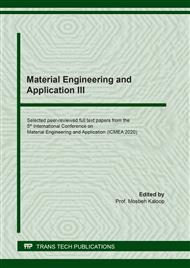p.13
p.19
p.25
p.31
p.39
p.45
p.51
p.57
p.67
Effects of 1,2-Dihydro-2,2,4-Trimethyl-Quinoline (TMQ) Antioxidant on the Marshall Characteristics of Crepe Rubber Modified Asphalt
Abstract:
The use of natural rubber-like crepe rubber as an asphalt additive is very susceptible to aging. Aging on asphalt crepe rubber can occur during the mixing process or its use for the road. Studies on the prevention of aging on asphalt are still being developed to produce asphalt resistance to aging and have good performance in preventing deformation. Some studies that have been done are the addition of other additives such as antioxidants. This study aims to study the effect of adding crepe rubber and the antioxidant 1,2-dihydro-2,2,4-trimethyl-quinoline (TMQ) to the Marshall characteristics of rubber asphalt. Preparation of the rubber asphalt sample begins with making crepe rubber, which is by milling raw natural rubber in the form of a cup lump using a creeper. The crepe rubber product contains dry rubber content of more than 95%. Then the crepe rubber masticated using an open mill to soften and form it with 2 mm thickness. Then the crepe rubber is melted at 200 °C before being mixed with asphalt, heated to 165 °C. The crepe rubber content in the asphalt mixture is made 10%, and during the mixing process, the TMQ was added with contents of 0%, 1%, 2%, 3% w/w. The rubber asphalt samples were then tested for their penetration and marshall characteristics, using ASTM D5 and ASTM D6927 standards. The test results show that the addition of the TMQ can improve the penetration properties and stability of the rubber asphalt in holding the load. However, the addition of the TMQ of more than 2% causes a decrease in the rubber asphalt's stability properties. The best results were obtained by adding 2% TMQ with 68.7 dmm penetration and optimum asphalt content of 5.50%. Results of the marshall test for the sample are marshall stability 1403.96 kg, void filled aggregate (VFA) 75.90%, void in a mixture (VIM) 3.07%, void mineral aggregate (VMA) 15.34%, flow 3.370 mm, and marshall quotient (MQ) 420.8 kg/mm.
Info:
Periodical:
Pages:
39-44
Citation:
Online since:
February 2021
Authors:
Keywords:
Price:
Сopyright:
© 2021 Trans Tech Publications Ltd. All Rights Reserved
Share:
Citation:


